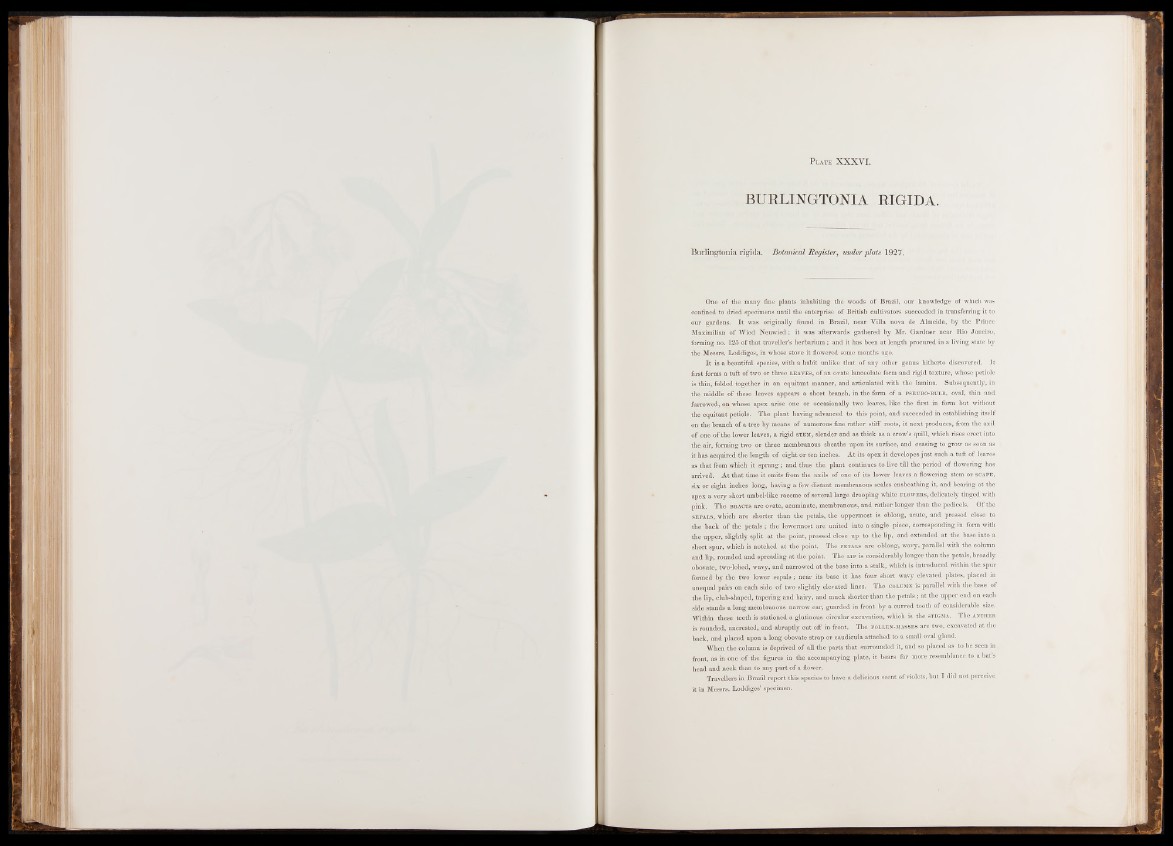
BURLINGTON!A RIGIDA.
Burlingtonia rigida. Botanical Register, under plate 1927.
One of the many fine plants inhabiting the woods of Brazil, our knowledge of which was
confined to dried specimens until the enterprise of British cultivators succeeded in transferring it to
our gardens. It was originally found in Brazil, near Villa nova de Almeida, by the Prince
Maximilian of Wied Neuwied; it was afterwards gathered by Mr. Gardner near Rio Janeiro,
forming no. 125 of that traveller’s herbarium ; and it has been at length procured in a living state by
the Messrs. Loddiges, in whose stove it flowered some months ago.
It is a beautiful species, with a habit unlike that of any other genus hitherto discovered. Jt
first forms a tuft of two or three leaves, of an ovate lanceolate form and rigid texture, whose petiole
is thin, folded together in an equitant manner, and articulated with the lamina. Subsequently, in
the middle of these leaves appears a short branch, in the form of a pseudo-bulb, oval, thin and
furrowed, on whose apex arise one or occasionally two leaves, like the first in form but without
the equitant petiole. The plant having advanced to this point, and succeeded in establishing itself
on the branch of a tre;e by means of numerous fine rather stiff roots, it next produces, from the axil
of .one of the lower leaves, a rigid stem, slender and as thick as a crow’s quill, which rises erect into
the air, forming two or three membranous sheaths upon its surface, and ceasing to grow as soon as
it has acquired the length of eight or ten inches. At its apex it developes just such a tuft of leaves
as that from which it sprang; and thus the plant continues to live till the period of flowering has
arrived. At that time it emits from the axils of one of its lower leaves a flowering stem or scape,
six or eight inches long, having a few distant membranous scales ensheathing it, and bearing at the
apex a very short umbel-like raceme of several large drooping white flowers, delicately tinged with
pink. The bracts are ovate, acuminate, membranous, and rather longer than the pedicels. Of the
sepals, which are shorter than the petals, the uppermost is oblong, acute, and pressed close to
the back of the petals; the lowermost are united 'into a single piece, corresponding in form with
the upper, slightly split at the point, pressed close up to the lip, and extended at the base into a
short spur, which is notched at the point. The petals are oblong, wavy, parallel with the column
and lip, rounded and spreading at the point. The lip is considerably longer than the petals, broadly
obovate, two-lobed, wavy, and narrowed at the base into a stalk, which is introduced within the spur
formed by the two lower sepals; near its base it has four short wavy elevated plates, placed m
unequal pairs on each side of two slightly elevated lines. The column is parallel with the base of
the lip, club-shaped, tapering and hairy, and much shorter than the petals; at the upper end on each
side stands a long membranous narrow ear, guarded in front by a curved tooth of considerable size.
Within these teeth is stationed a glutinous circular excavation, which is the stigma. The anther
is rounded, uncrested, and abruptly cut off in front. The pollen-masses are two, excavated at the
back, and placed upon a long obovate strap or caudicula attached to a small oval gland.
When the column is deprived of all the parts that surrounded it, and so placed as to be seen in
front, as in one of the figures in the accompanying plate, it bears far more resemblance to a bats
head and neck than to any part of a flower.
Travellers in Brazil report this species to have a delicious scent of violets, but I did not perceive
it in Messrs. Loddiges’ specimen.